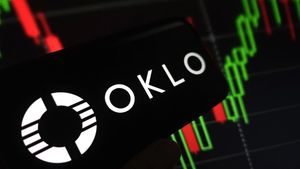
New York, NY – September 26, 2025 – The financial markets today reacted with cautious optimism as the Personal Consumption Expenditures (PCE) inflation data for August 2025 largely met Wall Street's expectations. This crucial economic indicator, the Federal Reserve's preferred gauge of inflation, provided a degree of reassurance to investors, leading to an uptick in Dow (INDEXDJX: .DJI), S&P 500 (INDEXSP: .INX), and Nasdaq (INDEXNASDAQ: .IXIC) futures ahead of the New York Stock Exchange open. The report, which also highlighted slightly stronger personal income and spending, paints a picture of a resilient U.S. economy navigating persistent, yet stable, inflationary pressures.
The immediate implications suggest that while inflation remains above the Federal Reserve's 2% target, it is not accelerating unexpectedly, potentially keeping the door open for the central bank's anticipated, albeit cautious, monetary easing path. However, the underlying strength in consumer spending could complicate the Fed's decisions, as it balances inflation control with robust economic activity.
Detailed Coverage: August PCE Data Aligns with Expectations Amidst Robust Consumer Activity
The August 2025 Personal Consumption Expenditures (PCE) inflation data, a crucial metric for the Federal Reserve's monetary policy, was released today, Friday, September 26, 2025, at 8:30 a.m. EDT (12:30 GMT) by the U.S. Bureau of Economic Analysis (BEA). The report indicated that both headline and core inflation figures largely aligned with market consensus, while personal income and spending demonstrated slightly stronger growth than anticipated.
Specifically, the Headline PCE Price Index rose by 0.3% month-over-month (MoM), meeting consensus forecasts, and increased by 2.7% year-over-year (YoY), also matching expectations. The Core PCE Price Index, which excludes volatile food and energy components and is the Fed's primary focus, increased by 0.2% MoM, consistent with expectations, and held steady at 2.9% YoY, in line with forecasts. Furthermore, Personal Income saw a 0.4% MoM increase, marginally exceeding the 0.3% consensus, and Personal Spending rose by 0.6% MoM, coming in above the 0.5% forecast.
Leading up to this release, market participants were keenly awaiting the PCE data, particularly after Fed Chair Jerome Powell had previously indicated that the annual PCE rate for August was projected around 2.7%, and core PCE at 2.9%, precisely matching today's reported figures. This prior guidance likely contributed to the muted immediate market reaction, as the data contained no major surprises. Despite inflation holding above the Fed's 2% target, there was a broad market expectation for the Federal Reserve to implement further interest rate cuts in 2025, including a potential 25 basis point reduction in October. However, concerns about new trade policies, such as tariffs, were also on analysts' radar, with expectations that these could push annual PCE inflation higher in the coming months.
Initial reactions from analysts suggest that the August PCE report provided a degree of reassurance to markets, reinforcing the Federal Reserve's cautious stance on inflation management. The in-line inflation numbers were seen as supportive of "further easing efforts," provided other inflation metrics remain under control. The slightly stronger personal income and spending figures, however, highlight continued consumer resilience, a factor that could introduce nuance into the Fed's future policy decisions as it balances inflation control with robust economic activity.
Companies and Sectors Poised to Win or Lose
The combination of PCE inflation data meeting expectations and robust consumer spending presents a mixed bag for various public companies and sectors. This scenario, characterized by underlying economic resilience, is likely to favor certain segments while posing challenges for others, particularly depending on the Federal Reserve's pace of interest rate adjustments.
Potential Winners:
Sectors that directly benefit from strong consumer demand and a stable, albeit moderately inflationary, economic environment are well-positioned. Consumer Discretionary companies are prime beneficiaries. With personal income and spending slightly stronger than anticipated, consumers have more disposable income for non-essential goods and services. This could boost major retailers like Amazon (NASDAQ: AMZN), Walmart (NYSE: WMT), and Target (NYSE: TGT), as well as travel and hospitality companies such as Carnival (NYSE: CCL), Royal Caribbean (NYSE: RCL), Delta Air Lines (NYSE: DAL), and Marriott International (NASDAQ: MAR). Automotive manufacturers like General Motors (NYSE: GM) and Ford (NYSE: F) could also see increased sales.
The Financials sector, including major banks like JPMorgan Chase (NYSE: JPM) and Bank of America (NYSE: BAC), could see improved net interest margins if interest rates stabilize or normalize at a slightly higher level due to a resilient economy. Increased consumer and business lending, spurred by stronger economic activity, would also boost profits. Service Industries generally thrive as consumers increase spending on income-elastic services, benefiting healthcare providers and various business services. Industrials (e.g., General Electric (NYSE: GE)), Energy (e.g., ExxonMobil (NYSE: XOM), Chevron (NYSE: CVX)), and Materials sectors may also benefit from their pricing power, allowing them to pass on rising input costs. Real Estate and Homebuilders (e.g., D.R. Horton (NYSE: DHI), Lennar (NYSE: LEN)) could also see renewed interest if the anticipation of potential rate cuts and healthy consumer finances stimulate housing activity.
Potential Losers (or less favored):
Conversely, some sectors might face headwinds. Highly Leveraged Growth Stocks, particularly in the Technology sector, could see their valuations pressured if interest rates remain "higher for longer" or if the anticipated rate cuts are fewer and later than expected. Companies with high debt loads or those not yet consistently profitable, which often rely on cheaper capital for growth, could find their cost of capital increasing. While technology generally benefits from a stable economy, a cautious Fed approach could temper its performance.
Consumer Staples (e.g., Procter & Gamble (NYSE: PG), Coca-Cola (NYSE: KO)) and Utilities (e.g., NextEra Energy (NYSE: NEE), Duke Energy (NYSE: DUK)), while defensive and offering stability, may not see significant upside from stronger consumer discretionary spending. These sectors are also consumers of commodities, and rising input costs could compress their profit margins if they struggle to pass these costs onto consumers. In essence, a "Goldilocks" scenario of in-line inflation and resilient consumer demand favors cyclical sectors, but the Fed's measured approach could temper enthusiasm for highly growth-dependent or defensive sectors.
Wider Significance: Navigating a Resilient Economy and Policy Crossroads
The August 2025 PCE inflation data, combined with robust personal income and spending, carries significant weight for the broader U.S. economy, fitting into ongoing trends of economic resilience and presenting crucial policy implications. As the Federal Reserve's preferred measure, PCE data offers a comprehensive view of consumer spending and its inflationary impact, accounting for approximately two-thirds of domestic spending and thus acting as a primary driver of GDP.
This scenario of stable, albeit elevated, inflation alongside strong consumer activity suggests the U.S. economy is currently navigating a "soft landing" trajectory. Consumers possess both the capacity and willingness to spend, fueling economic growth without an immediate re-acceleration of inflationary pressures. This resilience is a key broader industry trend, supporting consumer-facing sectors like retail, hospitality, and entertainment. It also offers a favorable backdrop for technology and growth stocks, assuming borrowing costs remain manageable or gradually decline.
However, ripple effects are multifaceted. Increased consumer demand could intensify competition across various sectors, pushing companies to innovate and offer more competitive pricing. While favorable financing conditions could spur mergers and acquisitions, businesses relying on complex international supply chains might face ongoing challenges from global inflation trends and currency movements, potentially accelerating trends like nearshoring.
For the Federal Reserve, the data reinforces a cautious, data-dependent approach to monetary policy. The Fed's dual mandate of maximum employment and price stability means it must carefully balance controlling inflation (which remains above its 2% target) with supporting continued economic growth. The August PCE report, by largely meeting expectations, reduces the urgency for aggressive tightening but also doesn't provide a strong impetus for rapid, deep rate cuts, especially given the strength in consumer spending. This delicate balancing act could lead to a protracted period of gradual adjustments rather than sharp policy shifts.
Government fiscal policy also plays a role. A healthy economy with strong consumer activity might lead to higher tax revenues. However, if strong spending is disproportionately concentrated among higher-income households, as some reports suggest, it could spark calls for policies addressing income inequality. Furthermore, trade policies, such as tariffs, remain a significant governmental factor. Any new tariffs could directly impact inflation by increasing goods prices, complicating the Fed's efforts to achieve its target.
Historically, this period draws comparisons to the Post-World War II Boom (mid-1950s to late 1960s), an era characterized by strong consumer demand, a booming economy, and low, stable inflation. This contrasts sharply with the "Great Inflation" (1965-1982), a cautionary tale of unchecked inflation due to excessive money supply. The current scenario suggests a more controlled environment compared to the post-pandemic inflationary surge of the early 2020s. While not a mirror image of any single historical period, the present situation underscores the importance of vigilant policymaking to sustain growth while taming persistent inflationary forces.
What Comes Next: Navigating a Path of Cautious Optimism
The U.S. economy's future trajectory, shaped by the latest PCE inflation data and robust consumer spending, points towards a path of cautious optimism, demanding strategic pivots from both businesses and investors. In the short term, the economy is expected to remain resilient, with upward revisions to full-year 2025 GDP growth projections, potentially in the 2.8% to 3.2% range. However, market volatility is likely to persist as investors quickly reprice assets based on incoming economic data and Federal Reserve communications. A cooler-than-expected inflation reading could trigger a relief rally, especially in growth-oriented sectors.
For the long term, economic growth is projected to moderate but remain above historical averages through the end of 2025, with a gradual normalization anticipated in 2026. This implies a "soft landing" scenario, where inflation recedes without a significant economic downturn. However, the stickiness of core inflation and the strength of consumer spending mean the Federal Reserve's monetary policy will be a critical determinant of this outcome.
Strategic Pivots and Adaptations:
- Businesses must prioritize agile financial planning, robust supply chain resilience, and nuanced pricing strategies. Investing in operational efficiency through automation and focusing on high-impact, data-driven marketing will be crucial. Innovation and diversification of product portfolios will help meet evolving consumer needs and reduce reliance on single revenue streams.
- Investors should recalibrate their expectations regarding Federal Reserve rate cuts, anticipating a more measured pace than previously forecast. Asset allocation should consider tangible assets like real estate and commodities as potential inflation hedges, alongside Treasury Inflation-Protected Securities (TIPS). A focus on sectors benefiting from sustained consumer confidence, such as retail and banking, is advisable. Maintaining a flexible portfolio and prioritizing companies with strong, transparent revenue growth will be key.
Market Opportunities and Challenges:
Opportunities abound in consumer-driven growth sectors, particularly services like travel and entertainment. The Artificial Intelligence (AI) boom continues to drive investment in technology and specialized tech roles. The resource sector also benefits from electrification initiatives and global infrastructure development. However, challenges include persistent core inflation driven by tariffs and sticky service costs, ongoing monetary policy uncertainty, and the growing income inequality impacting consumer spending patterns. Higher borrowing costs and geopolitical factors also remain significant headwinds.
Potential Scenarios for Monetary Policy and Economic Growth:
The most probable scenario for monetary policy is Cautious Easing, with the Federal Reserve continuing its measured approach, potentially implementing fewer rate cuts than previously expected (e.g., 2-3 more by early 2026). A more hawkish stance could emerge if inflation proves more persistent, while an increased emphasis on employment could lead to more gradual easing if inflation trends allow. For economic growth, a Resilient but Moderating Growth path is expected, with the economy successfully navigating post-pandemic adjustments. A downside risk is Sticky Inflation and Slower Growth, where persistent core inflation and slowing real disposable income growth lead to below-trend economic expansion. Achieving a Soft Landing remains a possibility but requires a delicate balance from the Federal Reserve.
Comprehensive Wrap-up: Navigating Persistent Inflation with Resilient Demand
The August 2025 PCE inflation data, released today, September 26, 2025, delivered a critical update to the financial markets, confirming that while inflation remains elevated, it is largely tracking expectations. The key takeaway is the persistence of core PCE inflation at 2.9% year-over-year, alongside robust personal income and spending, which rose by 0.4% and 0.6% respectively. This indicates a U.S. economy that is resilient on the consumer front but still grappling with entrenched inflationary pressures that are proving difficult to fully dissipate.
Moving forward, the market assessment suggests a period of continued vigilance. The immediate muted reaction to the PCE data reflects its alignment with forecasts, but the underlying narrative of "sticky" inflation above the Federal Reserve's 2% target will heavily influence future monetary policy. While the data might support the notion of further easing efforts by the Fed, the strength in consumer spending could temper the pace of these cuts, as the central bank balances its dual mandate of price stability and maximum employment.
The lasting impact of this data underscores that the "last mile" of disinflation is indeed the hardest. The sustained level of inflation, despite initial easing by the Fed, highlights that the path to the 2% target will likely be protracted and data-dependent. This means investors should anticipate a cautious approach from the Federal Reserve, with any future rate adjustments being carefully weighed against incoming economic indicators. The continued buoyancy in consumer spending is a double-edged sword: it signals economic health but also risks sustaining demand-side inflationary pressures.
What Investors Should Watch For in Coming Months:
- Future Inflation Data: Closely monitor subsequent PCE and Consumer Price Index (CPI) releases. Any significant re-acceleration of core inflation could prompt a more hawkish stance from the Fed.
- Federal Reserve Communications: Pay close attention to statements and speeches from Fed officials for clues on their evolving outlook regarding inflation, growth, and the timing/magnitude of future interest rate adjustments.
- Labor Market Reports: Employment data, including non-farm payrolls, unemployment rates, and wage growth, will be crucial. A significant deterioration in the labor market could increase pressure on the Fed to prioritize economic support.
- Consumer Spending Trends: Continue to monitor retail sales and consumer confidence indicators to assess the sustainability of current spending levels.
- Global Economic Developments: Geopolitical events, supply chain dynamics, and economic conditions in major trading partners will also influence domestic inflation and growth.
In summary, the August PCE data reinforces the notion of persistent, albeit stable, inflation. Investors should prepare for continued vigilance from the Federal Reserve and a data-dependent approach to monetary policy, with a keen eye on upcoming economic releases that will shape the Fed's next moves.
This content is intended for informational purposes only and is not financial advice.





